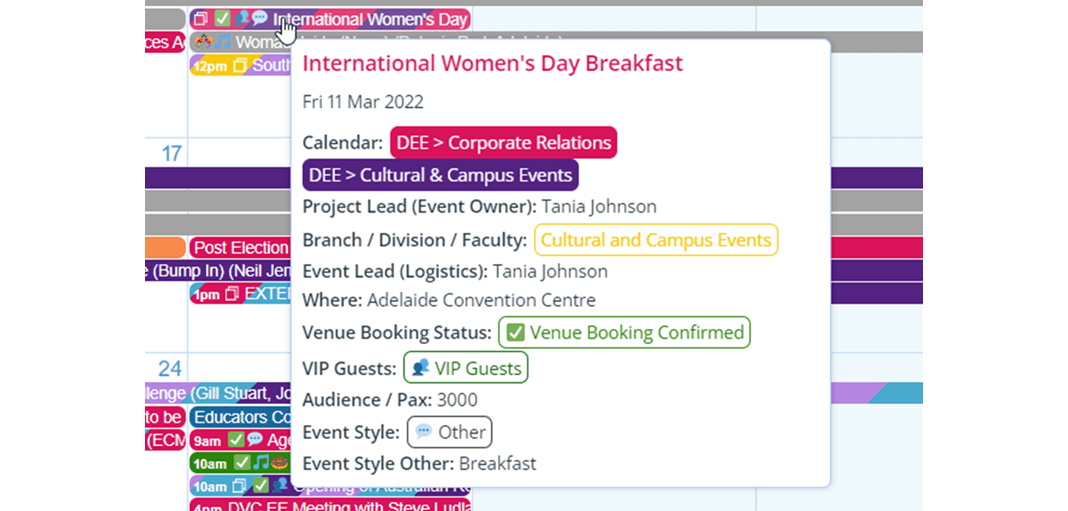This is a guest post by Auria Heanley, co-founder of Oriel Partners, a boutique PA and EA recruitment consultancy based in Central London.
In my role as a recruiter, I’ve worked with hundreds of Executive Assistants, from those supporting one senior leader to others managing multiple C-suite diaries across global time zones. And no matter the industry, the one skill that consistently separates high-performing EAs from the rest is this: they know how to manage schedule information brilliantly.
It’s not just blocking out meetings or checking calendars. Effective scheduling is about planning, prioritising and controlling time so that the right things happen at the right time for the right people. That’s no small feat when your day includes board meetings, last-minute travel changes, client calls, and internal priorities all competing for attention.
In this guide, I’ll share how the most successful EAs I work with organise complex schedules in a way that supports productivity, protects their executives’ time, and reduces stress.
The scheduling chaos EAs face (and why it hurts performance)
When I speak to executive assistants in the early stages of a job search, one theme always comes up: scheduling is often the most mentally draining part of the role.
That’s no surprise. EAs are managing far more than a daily schedule; they often also handle:
- Multiple diaries
- Constant rescheduling
- Complex meeting logistics
- Shared resources like boardrooms and equipment
And all of this is often under tight time constraints.
On top of that, they’re the go-between for stakeholders with conflicting priorities: internal teams, external clients, investors, travel coordinators, and occasionally an exec who prefers last-minute changes.
With so many moving parts, it’s easy for schedule information to become scattered, unclear, or out of sync.
And when that happens?
- Deadlines are missed.
- Teams turn up to the wrong room.
- Time is wasted.
- Projects lose momentum.
Poor time management doesn’t just affect one person, it slows down the entire project and chips away at mental wellbeing, both for the assistant and their executive.
The truth is, schedule management doesn’t mean simply fitting things in. It means controlling the process, tracking what matters, and creating space for deep work and clear thinking.
That’s why the most effective EAs build systems to manage not just tasks and calendars, but the information behind them, and we’ll explore an effective schedule management process in the steps ahead.
Step 1: Create a system that captures all scheduling inputs
The first mistake even seasoned EAs make is relying on their memory or too many disconnected tools to manage schedule inputs. Meetings get suggested in Slack, actions discussed verbally in the hallway, tasks come through email, and suddenly your schedule isn’t just busy, it’s fragmented.
To manage effectively, you need a centralised system that captures everything. Not just confirmed meetings, but tentative requests, room bookings, recurring events, and anything that might impact availability or resources.
You need a system that creates a clear picture of the entire project or workload, not just the visible appointments.
Tools like Teamup can act as this single source of truth. Unlike personal calendar apps, it’s designed to support shared scheduling across people, rooms, equipment, and departments.
For an EA, managing an executive’s diary alongside meeting room availability, team offsites, and client lunches, all in one place can be game-changing. It gives real control over the schedule without toggling between apps or duplicating tasks.
When you start capturing everything in one system, you gain clarity. You can better determine what’s actionable, what’s a conflict, and where you have buffer time. Without this foundation, even the best time management techniques won’t stick because the inputs themselves are incomplete.
Step 2: Break projects down into manageable tasks
Great executive assistants understand that effective scheduling starts with clarity of scope. That means turning vague requests or large goals into clearly defined, manageable tasks.
Let’s say your executive asks you to “organise the Q4 strategy day.” That’s not one task. It’s a project, and it needs to be treated like one.
A skilled EA will use a light version of a work breakdown structure, listing all the steps involved. For example:
- Sourcing venues
- Aligning stakeholder availability
- Preparing project materials
- Sending invites
- Managing catering
- Confirming travel
- Ensuring tech runs smoothly.
Each of these tasks becomes a discrete, trackable item with its own completion date.
In tools like Teamup, you can visually map the timeline of each task and assign deadlines that align with the project’s goals. You can leverage the flexibility of custom fields to capture any important input / output and the status of each task.

When you break large projects into smaller, clearer chunks, you avoid bottlenecks and reduce the risk of delays. You also make it easier to reallocate resources, estimate how much time is truly needed, and ultimately meet deadlines even when life throws in a last-minute curveball.
Step 3: Prioritise with purpose — not just urgency
When everything feels urgent, it’s hard to see what’s truly important. As an EA, your value often lies in knowing the difference and making judgment calls that protect your executive’s time while keeping the wider team and project on track.
I often remind assistants of the Mark Twain “eat the frog” technique: If you start your day with your most difficult or valuable task, everything else feels easier.
But prioritisation is more than tackling the hard stuff first. It requires aligning your daily schedule with strategic goals and controlling what gets through the gate.
For example, a request from your CEO to prep board materials may take precedence over a last-minute team lunch booking, even if the lunch request is louder.
This is where a good system helps. With the right tool, you can colour-code tasks, label priority levels, and schedule low-priority tasks into protected afternoon slots, freeing your mornings for important tasks that require more focus.
When you manage priorities proactively, you take control of your schedule instead of reacting to it. You’ll find it easier to meet key completion dates, manage time constraints, and shift non-essential items without guilt, because you’ve already done what matters most.
Step 4: Use tools that provide control, visibility & flexibility
Most EAs I work with start out using Google Calendar or Outlook, and they do work to a point. But when you’re managing not just one executive, but a whole network of people, rooms, resources, and timelines, those tools often hit their limits. That’s when things start falling through the cracks.
To manage complex scheduling information, you need project scheduling software that gives you true visibility. That means seeing multiple calendars side by side, scheduling meetings that don’t clash with travel plans, and tracking project timelines across departments all in one view.
Unlike traditional calendars, resource scheduling calendars are designed with shared scheduling in mind.
You can:
- Create separate calendars for different execs, rooms, or teams
- Track resource allocation — like boardroom bookings or shared equipment
- View everything in timeline or Gantt-style formats
- Easily update the entire team on changes, without endless back-and-forth
One EA I placed used scheduling software to manage a product team’s sprint cycles alongside the exec’s diary and company-wide town halls. It became her project management software, not just a calendar, allowing her to track the entire project from kick-off to delivery, including key end dates and milestones.
Ultimately, the right tool helps you do more than schedule. It gives you control over your time, your team’s availability, and the pace of progress. And when you’re able to implement a system that supports that, you don’t just manage, you lead.
Step 5: Track progress and review to stay on target
Scheduling is a living process. Great EAs don’t just plan once and hope for the best. They build in regular checkpoints to track progress, review what’s been completed, and make adjustments when timelines or resources shift.
For example, if you’re coordinating a launch event, it’s not enough to mark the final date in your calendar and leave it at that. Instead, break it into milestones like:
- Confirming the venue
- Finalising the guest list
- Preparing materials
Then check in weekly:
- What’s done?
- What’s delayed?
- What needs escalation?
This kind of proactive approach transforms your system into more than a list of tasks. It becomes a tool for monitoring the project’s goals and keeping the entire team aligned.
Most importantly, schedule time to review. At the end of each week, spend 10 minutes reflecting:
- What went well?
- Where did you run into time constraints?
- What needs more planning next time?
That reflection process is key to continuous improvement, and it helps ensure your next project runs even more smoothly.
Step 6: Protect your time and mental wellbeing
I’ve spoken to numerous EAs who feel permanently switched on, juggling daily tasks while navigating last-minute changes, time zone issues, and overlapping meetings. Without boundaries, even the best systems start to buckle under pressure.
That’s why building a schedule that protects your focus and your energy, as well as that of your executive, is just as important as managing resources and deadlines.
I always recommend time-blocking for routine tasks, and buffer time between high-focus meetings. Use your calendar to ring-fence your own planning sessions or catch-up windows. Make sure to schedule free time proactively and avoid back-to-back overload.

Small changes make a big difference. Colour-coding your day by energy level, blocking out admin hours, or even scheduling in a short walk are all valid time management strategies that support productivity in a sustainable way.
When your schedule supports your well-being, you’re in a far better position to support others, and that’s what being an exceptional EA is all about.
Calm scheduling = Powerful support
Managing schedule information requires structure, clarity, and staying one step ahead. As an executive assistant, your ability to create order out of complexity is what enables your executive, your team, and your entire organisation to function at their best.
Whether you’re supporting one CEO or a whole department, the right tools and techniques can help you meet deadlines, manage priorities, and reduce stress for everyone involved.
If you’re looking for an efficient way to bring it all together, Teamup can be a game-changer.



